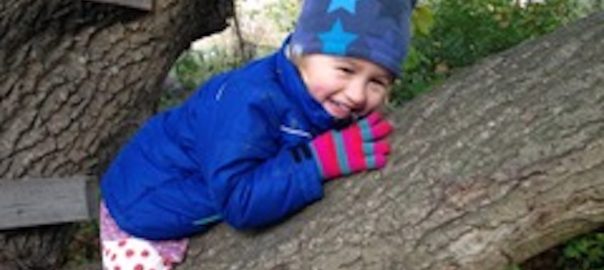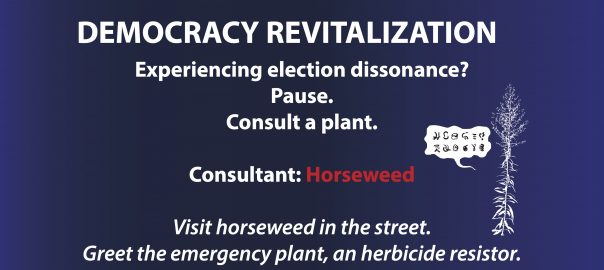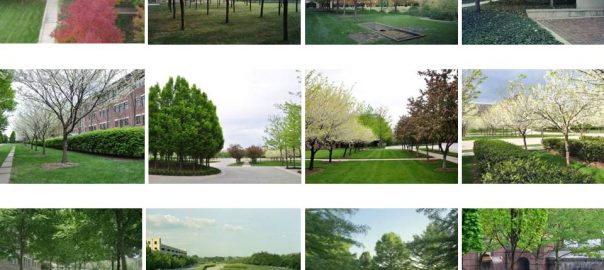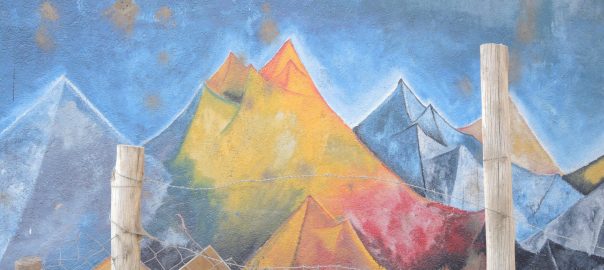I live in Stockholm, Sweden. I enjoy talking walks in the autumn, inhaling the scent from degrading debris, kicking around dead leaves, and gazing at the vivid colors. This fall, my baby daughter has often followed me on my walks. Her name is Viola, and she is 4 years old.
Without critical discussion at Habitat III, could Smart City policies further disconnect children from experiences of nature?
Viola and I often walk to the grocery store to buy stuff missing for dinner. Farther on our path is a playground. Viola frequently stops and play for a while. Sometimes, we take a prolonged route through a forest grove on the way back to our apartment. It is not far away. In the forest, she often discovers tiny animals and plants, and asks me trillions of questions. I try to answer her every time. Sometimes, I do it in a mindful way, sharing her enthusiasm in the moment. But too often, I answer in an absentminded way, my mind unconsciously wandering to reflect on the experiences of today’s work and many other things.

Viola found an acorn on our path the other day: “What is this?” she asks. I point my finger towards an oak tree and answer her: “This is the seed of such a tree over there”. While gazing at the crown of the oak, she says: “It is amazing that a small acorn can transform into such a big tree”. Her comment surprises me and causes a warm sensation of affection in me as we share this moment of awe. But I just nod in a kind of stiff, Swedish way.
I tell her a story about the “forgetful Jay” that collect acorns for winter and then buries them into the ground. I tell her that the bird forgets most of them, and that this is how oak trees around here regenerate into new, big oak trees. I also tell her that an oak can live for a thousand years, and that there probably are many acorns in the ground around here that could grow into new oaks. She looks at the acorn for a short while, puts it in her pocket, and then we continue our walk back home. I ponder the experience we just had together. Someday, I will tell her that the Jay also need forests of pine for its needs, and about how different habitats are connected to form part of an ecological memory of the urban landscape we live in. I will teach her about the beauty of “slowness” in ecosystem dynamics.
As we continue our walk back home, my mind unconsciously wanders on. How interested will Viola actually be in learning about ecological memory, as narratives of what constitutes “a good life” increasingly might be shared on social media?
All this makes me think of Habitat III.
Habitat III
45,000 people supported by the UN met in Quito to discuss urban sustainability during the Habitat III conference. What’s new since the last conference, 20 years ago? The “Smart City” concept has entered the scene as a promising paradigm for a transition towards urban sustainability (HABITAT III, p. 10).
From a birds-eye perspective, the Smart City concept could perhaps simply be described by the words: rapid, digital, reflecting “the wired-in city”! It is the Internet of Things in the City! It is about increasing efficiency, which is important in terms of metabolic flows and regarding governance systems, as people attempt to cut costs and to decrease local and global pollutants.
There are naturally many positive aspects to wired-in infrastructures, some of which have been discussed before on The Nature of Cities. In 2012, Philip Silva wrote about cities as “cyborgs”, or hybrids between ecosystems and artificial systems, and that smart city solutions can and should work to clean and support local ecosystems. That blog made a lot of sense to me. But there are also critical voices of the Smart City movement. For instance, Sumetee Gajjar and Harini Nagendra raised questions regarding whether Smart City policies in India will include thinking about good governance and about local democracy, and whether such policies will blur the role that urban ecosystem services play in people’s well-being: wise words from India. Hollands (2008) questions whether the Smart City concept is for big business or for urban citizens.
Were such issues discussed in Quito?
Nowhere in the HABITAT III document is there any critical thinking addressing that the Internet of Things inevitably also means ever more screen time for people in their daily routines. It is noteworthy to mention here that increased screen time is discussed as a force driving kids to spend less time outdoors. In a recent paper, Soga et al., (2016) highlight examples where children in Japan spend much less time in natural environments compared to only 10 years ago, and that 12 percent of English kids have not visited a natural environment in the 12 months prior to the study.
Could Smart City policies unintentionally serve to further disconnect children from experiences of nature, perhaps inducing grand processes of social amnesia? Social-ecological memory (Barthel et al., 2010) involves the linking of social memory and ecological memory. Social memory refers to the accumulated collective experiences and knowledge of social groups or cultures, whereas ecological memory pertains to the remnants of biodiversity and spatial connectivity that persist in an area in the wake of a disturbance, such as a fire, flood, or construction of a road. As the ecosystem recovers from disturbance, ecological memory influences its reorganization. With a high degree of memory retention, the reorganized state of the system is more likely to resemble its former (i.e., pre-disturbance) state, but with low memory retention, the result of reorganization may be a fundamentally different, alternative stable state. Social-ecological memory is the collective memory of management practices that sustain ecological memory (Andersson & Barthel 2016).
How is social-ecological memory retained and eroded, and what might be the consequences of each? Integral to the production and persistence of memory are memory carriers—repositories and structures by which experiences and processes are transported in space and time (Ibid.).
Memory carriers may be ecological (e.g., gene pools, seed banks, and tree groves) or social (e.g., oral traditions, social norms, and media); improved understanding of how ecological and social memory carriers interact is hypothesized to be useful for fostering social-ecological memory and imagining new (or, perhaps, remembering old) avenues for place-based, sustainable living in the midst of rapidly unfolding global change. Alternatively, the loss of social-ecological memory may not only erode capacities for management of local ecosystems, but may also induce a broad societal shift in a psychological connection with nature.
In psychological literature, a connectedness with nature may be defined as an individual’s affective and experiential connection to nature (Mayer & Frantz, 2004, p. 504). As such, it can be viewed as a deep-seated attitude that forms an important part of predicting pro-environmental behavior (Ives et al., 2016). Of late, this perspective has also caught interest in sustainability science. An upcoming research group in Germany has identified a connectedness with nature as a “deep leverage point” for sustainability transformation (Abson et al., 2016).
Concerns are being raised about drivers that challenge people’s direct, sensory experience of nature and threaten to trigger baseline changes in people’s psychological connections with nature (Hartig and Kahn 2016). This is especially pressing from a children’s point of view. A deep-seated psychological connection with nature is most easily acquired during childhood (Giusti, et al., 2014; Cheng and Monroe, 2012; Chawla & Cushing, 2007) and persists unchanged through adulthood (Kaiser et al., 2014). To quote Miller (2005), “[if] people no longer value nature or see it as relevant to their lives, will they be willing to invest in its protection?”
Nearly home now…
We continue our walk home, dusk approaching, and the northern sky turning pink, my thoughts wandering mindlessly…Will our walks make any difference? Will they help instill Viola with a sense of care for nature? How will Smart City policies interfere with Viola’s experiences in the near future?…How is it possible that the voice of Nick Drake holds such sensitivity and wisdom despite that he passed away in his twenties? Probably I am just getting old…
Viola runs ahead of me towards our front door. We are home. Viola has an acorn in her pocket.
….“I never felt magic crazy as this…”
Stephan Barthel
Stockholm
Literature
Abson, D. J., Fischer, J., Leventon, J. et al. 2016. Leverage points for Sustainability Transformation. Ambio, doi:10.1007/s13280-016-0800-y
Andersson, E. and S. Barthel. 2016. Memory carriers and stewardship of metropolitan landscapes. Ecological Indicators 70:606-614.a
Barthel, S., Folke, C. and Colding, J. (2010). Social-Ecological Memory in Urban Gardens – Retaining the capacity for management of ecosystem services. Global Environmental Change, 20(2): 255-265
Chawla, L. & Cushing, D. 2007. Education for strategic behavior. Environmental Education Research, 13(4): 427-452.
Cheng, J. C. H. & Monroe, M. C. 2012. “Connection to Nature: Children’s Affective Attitude toward Nature.” Environment and Behavior 44(1): 31–49.
Giusti, M., Barthel, S. & Marcus, L. 2014. Nature Routines and Affinity with the Biosphere: A Case Study of Preschool Children in Stockholm. Children, Youth and Environments, 24(3): 16-42.
HABITAT III NEW URBAN AGENDA. 2016. Draft outcome document for adoption in Quito, October 2016
Ives, C., Giusti, M., Fischer, J., et al. 2016. Human-nature connections: a review of the empirical evidence. Current Opinion in Environmental Sustainability-Forthcoming
Kaiser, F. G., Brügger, A., Hartig, T., et al. 2014. Appreciation of nature and appreciation of environmental protection: How stable are these attitudes and which comes first? Revue européenne de psychologie appliquée, 64: 269–277.
Mayer, F. & Frantz, C. 2004. The connectedness to nature scale: A measure of individuals’ feeling in community with nature. Journal of Environmental Psychology, 24: 503-515.







Leave a Reply